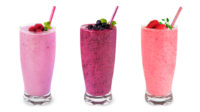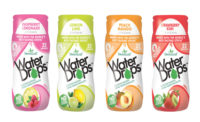More beverages are being developed with functional health properties and lower calories. As such, many of the functional ingredients and new sweeteners being included in beverages create flavor and aroma issues calling for a need to mask them.
Consumers are attempting to maintain or improve their health by consuming beverages and foods that are either curative to specific conditions or for overall preventative homeopathy, says Anton Angelich, group vice president of marketing at Virginia Dare, Brooklyn, N.Y.
“In a recent national survey of 483 baby boom consumers conducted by Virginia Dare, 66 percent of the respondents indicated that they felt that consuming certain foods or beverages could cure ailments, illnesses or conditions, and 80 percent felt such consumption could prevent ailments, illnesses and conditions,” he says. “As many new botanicals and food materials that have been used in dietary supplements in the past become utilized in consumer functional beverages, they require masking flavors to make the taste more widely acceptable to consumers.”
Educated, health-conscious consumers are turning to beverages for more than just fluid replenishment, agrees Tom Buco, president of Excellentia Inter-national, Edison, N.J. Consumers are looking for purposeful refreshment, he says.
“Thirst-quenching, empty calories are no longer enough,” Buco says. “Beverages are finally becoming nutrient delivery systems as they have been in Europe for decades and have led us to the continuation of shots.”
Educated consumers also are demanding botanical extracts with standardized active principals present in their beverages at levels generally regarded as efficacious, which have significantly challenged flavor houses’ abilities to deliver desired flavor profiles, Buco adds. In addition, stevia has opened new doors that still require flavor support for the ultimate goal of full sugar enjoyment and the elimination of stevia’s characteristic sensation of dryness, he says.
“Our efforts are dedicated to developing consumer-acceptable flavor profiles that overcome the unique taste, aroma, solubility and stability challenges represented by each of these trends,” Buco says.
Another continuing trend is to reduce calories in beverages and the continual development of new sweeteners. “Formulators are incorporating more and more non-nutritive sweeteners, whether it’s stevia or luo han guo,” says Tom Schufreider, vice president of marketing and business development at Synergy Flavors, Chicago. “Each one of these non-nutritive sweeteners brings its own flavor challenges to the developer and to the flavor creator.”
Masking solutions
When it comes to masking, beverage formulators are looking for many solutions, but above all they want to make their products taste great.
“The popularity of better-for-you or functional foods and beverages are evident everywhere,” explains Jim Hamernik, research and development director at Flavorchem Corp., Downers Grove, Ill. “This growing demand can involve flavor and odor challenges. Fortified products can have so many vitamins or proteins added to them that they really can taste undesirable. Companies come to us to make them taste ‘non-fortified.’”
The top reason why people don’t consume more functional beverages and foods is taste, adds Ed McIntosh, Flavorchem’s marketing manager. “Companies have different vitamins and different levels of fortifications, and we have to address each level of that to come up with something that is going to appeal to their consumer base,” he explains. “Simply put, if it doesn’t taste good, the product will unlikely succeed in the market regardless of its benefits.”
Flavorchem offers a wide line of masking and blocking agents for ingredients that exude bitterness, sodium, odors and other off-tastes, such as high-intensity and alternative sweeteners along with omega-3 fatty acids. Oftentimes, beverages require a custom masking agent, Hamernik says.
Beverage-makers are looking for clean, refreshing flavor profiles that cover the taste and aroma of various added nutrients. Unfortunately, many are looking for a “magic-bullet” solution to address all of those issues, which just does not exist, Excellentia International’s Buco says. As such, the company offers all types of masking solutions customized for specific applications and additive compositions.
“All our masking solutions are developed in situ and customized for the specific beverage formula,” Buco says. Excellentia International offers a customized developmental approach coupled with an understanding of the chemistry of natural products and backward integration into botanical extracts and distillates, he adds.
New extraction techniques of the phytonutrients commonly added to beverages causes the company to constantly re-evaluate and adapt its past work, Buco says. Natural phytonutrients that typically were consumed as tablets or capsules due to taste, aroma, solubility and stability challenges also are making their way into beverage applications, he adds.
“The answer is going to come from the botanical extract companies to do a better job at deodorizing some of these products, and the problem is, in some cases, the active principal is actually the thing that has the odor and taste,” Buco says.
The first question Synergy’s flavor creators will ask a customer wanting a masking agent is: What is it that the customer is trying to mask? Sometimes it’s not just about masking but finding the right flavor that works so well with the offending note that they just blend together, Schufreider says.
He agrees that a one-fits-all approach for a masking agent doesn’t work, particularly when it comes to proteins. Synergy is owned by the Carbery Group, Ballineen, Ireland, which manufactures protein and whey protein isolates and has a long history with protein and protein research.
“With that background and the work that has been done over the years with whey and whey protein, we understand how to mask whey protein and the notes that come out of whey,” Schufreider says. “Masking for whey is going to be different than masking for soy, which is going to be different from masking for other protein sources.
… Each one of those proteins hits your tongue in a different way.”
Virginia Dare continues to work on developing more flavor systems that provide the optimal masking of botanicals, vitamins, minerals, efficacious materials and alternative sweeteners, including stevia. David Michael & Co., Philadelphia, also offers masking technologies that work with many ingredients found in nutraceutical and performance beverages. These maskers are specific to ingredients, with examples that include the following: maskers for non-nutritive sweeteners’ bitter and astringent aftertaste, maskers for the astringency of botanical extracts, and maskers for the metallic taste of minerals and vitamins.
When it comes to sweeteners, beverage developers have a wide array of sweetening options other than sucrose from which to choose. Although they all have their pluses and minuses in replacing real sugar, the addition of a flavor can fill in profile gaps and help smooth out any rough edges, says Victoria Vaynberger, marketing and consumer insights manager at David Michael.
In addition, David Michael’s newest innovation, Sweetness Advantage, has been formulated to work specifically with Advantame, Ajinomoto’s newest compound. Sweetness Advantage is a natural and artificial, non-characterizing flavor that works in applications where Advantame is approved for use, including non-alcohol beverages, milk products and frozen dairy products.
“Sugar reduction across the entire category is a hot button to keep an eye on as well as fortified, functional and overall better-for-you beverages,” Vaynberger says. “Flavors that can deliver an indulgent, satisfying and enjoyable taste in a product that serves up health benefits are going to be key.”
Cincinnati-based Givaudan Flavors’ Taste Solutions program was specifically created to address all of the challenges associated with the creation of beverages that contain functional ingredients, natural sweeteners and artificial sweeteners.
“We have identified multiple individual challenges that can be affected when creating a beverage in these categories,” says Kim Carson, Givaudan’s marketing manager. “A few examples include bitter masking, mouthfeel enhancing, sugar reduction, and there are many more. For each one of these areas, we have created specific flavors to address these challenges.
“One of the most important findings over the years of research is that collaboration with the customer in developing the beverage product is key because the solutions may need to be adjusted with every change in the beverage base formulation,” Carson continues. “Solutions often need to be customized using multiple flavors to create the right balance and achieve the goal of creating a great-tasting beverage loved by consumers.”
Although more ingredients continue to be used in beverages that need to be masked, cleaner ingredients are becoming available to help flavor houses accomplish this task.
“Creating masking flavors requires a careful balance of creativity and science,” says Philip Barone, director of flavor development at California Custom Fruits and Flavors, Irwindale, Calif. “Using masking flavors properly is equally important to achieve the desired results.” BI





